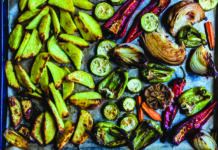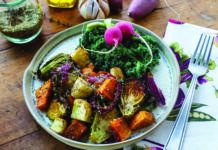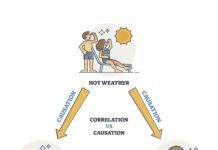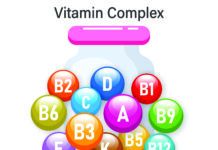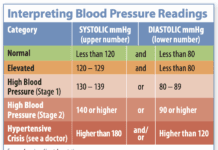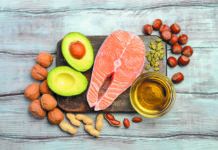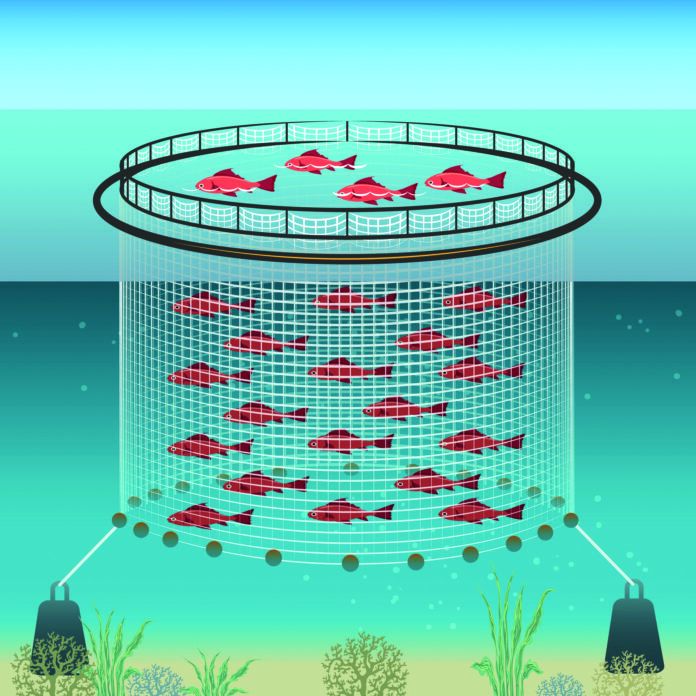The seafood counter can be a confusing place. Consumers may struggle to determine which fish, shellfish, and crustaceans are the “best” choices. The expert consensus is that, in general, they’re all good! Dietary patters rich in seafood are consistently associated with lower risk of cardiovascular disease, and the Dietary Guidelines for Americans recommend we eat at least two servings a week. “There’s no getting around the benefits of seafood,” says Timothy Griffin, PhD, Teri and Barry Volpert Family Professor in Nutrition, Agriculture, and Sustainable Food Systems at the Friedman School. “Lots of studies show if you eat more, you are healthier than if you eat less.’”
Seafood. What is generally referred to as “seafood” includes fresh water and saltwater fish, crustaceans (like shrimp, crab, and lobster), and shellfish (like clams and oysters). “The average American consumes about half of the recommended amount of seafood,” says Griffin. “If we actually met dietary intake recommendations, we’d need to buy or catch twice as much seafood.”
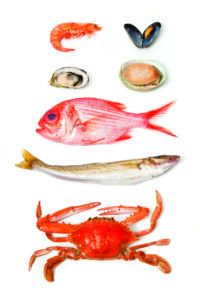
Nearly all types of fish, shellfish, and crustaceans are good choices—whether they are farmed or wild-caught.
Catching too many wild fish depletes the breeding population. This can cause species to become endangered and alter the ocean ecosystem. Aquaculture—raising seafood in net pens in the water or tanks or manmade ponds on land—is a way of providing seafood without overfishing wild species. (The National Ocean Service also uses aquaculture to replenish wild stocks and rebuild populations of threatened and endangered species.) But is farm-raised seafood inferior to wild caught? “We tend to think ‘natural’ foods —such as wild-caught fish—must be better,” says Griffin. “In the case of seafood, there is not a lot of evidence for that.”
It’s impossible to cover the pros and cons of all the different kinds of fish, shellfish, and crustaceans in every environment. However, if you want help deciding which choices are right for you, here’s some general information on three factors to consider—nutrient content, potential for contamination, and environmental impact.
Nutrient Content. Seafood is an excellent source of protein. The fat in seafood has a higher percentage of heart-healthy unsaturated fatty acids—and particularly polyunsaturated omega-3 fatty acids—than the fat in red meat and dairy. Omega-3 fatty acids are essential to human growth and development and are known to play beneficial roles in immune function and inflammation. They are considered beneficial to cardiovascular health (although supplementation with fish oil has not been proven beneficial). Oily fish (sometimes referred to as fatty fish), including salmon, mackerel, and sardines, are the best food source of animal-derived omega-3 fatty acids as well as vitamin D (which is found naturally in very few foods). Canned fish with bones, like sardines, anchovies, and salmon, also provide calcium. Shellfish, such as clams and oysters, are a good source of iron.
“When it comes to the nutritional value of farmed versus wild-caught seafood,” says Griffin, “there is not a consensus that one is always better than the other.”
Wild vs. farmed: For fish, the main nutritional difference between wild-caught and farmed is fat content, and even this difference is not very significant. Although fish are generally a low fat protein choice, wild-caught fish often have even less fat than farmed fish of the same species. This is due, in part, to differences in physical activity: fish in the wild swim more, so they have less fat in their muscle. The type of fat found in fish is not bad. Most of it, as we’ve already stated, is made up of desirable unsaturated fatty acids.
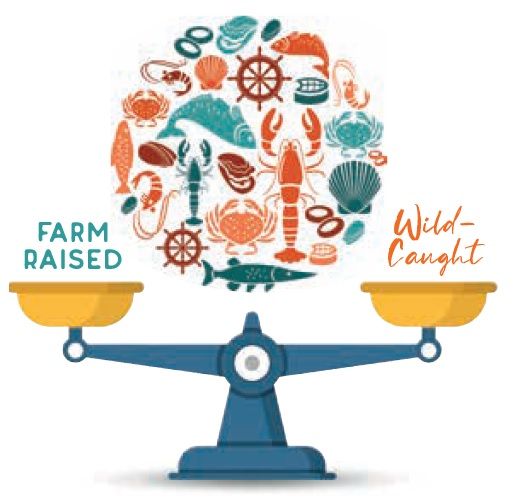
While wild fish eat smaller fish and aquatic plants, fish farms are increasingly using non-marine plants and plant oils to feed their stock. While this saves money and avoids impacting the aquatic ecosystem, it may change the nutrition profile of the fish. A study of Atlantic salmon found both wild-caught and farmed were good nutritional choices. The farmed salmon had substantially more total fat than their wild counterparts (which would likely make them more caloric), but the farmed fish were richer in unsaturated fatty acids as a result of their diet, whereas the wild salmon had a higher percentage of saturated fatty acids. (Remember, we should aim to consume less saturated fatty acids and more unsaturated, so this data could be seen as giving the farmed salmon a slight nutritional edge.) The wild salmon had a higher percentage of omega-3 fatty acids, but the actual content (in grams) was almost identical.
What to do: Seafood is nutritious regardless of whether it is farmed or wild-caught, particularly when it replaces meat and full fat dairy products in your diet.
Contaminants. Aquatic animals accumulate contaminants from the environment in which they are raised. Farmed and wild fish both contain contaminants, and one type is not consistently more or less contaminated than the other. It’s important to keep in mind that levels in nearly all fish are not considered harmful to human health.
Wild vs farmed: A study of Atlantic salmon (the most consumed species in the U.S.) found that wild-caught salmon had higher levels of contamination, specifically heavy metals like mercury and arsenic and industrial chemicals like polychlorinated biphenyls (PCBs), than farmed.
A common concern among consumers is mercury in fish. Mercury content of fish depends on species, size, what it eats, and where it grows up. Species with the highest levels include bigeye tuna, swordfish, king mackerel, marlin, orange roughy, shark, and tilefish from the Gulf of Mexico. These large predators accumulate many of the contaminants found in the smaller fish they eat.
What to do: It is generally acknowledged that the health benefits of eating fish and other seafood outweigh any potential risks from contaminants. Intake of the small number of species known to have high mercury content should be avoided, especially for young children and women who are pregnant or lactating. It’s important that pregnant women (or anyone) not avoid seafood altogether out of fear of contaminants. Limited data suggest that seafood consumption during pregnancy is associated with better neurocognitive outcomes in young children. (There are no data, however, to indicate taking fish oil supplements will have the same effect.) The U.S. Food and Drug Administration maintains an updated website on recommended limits for certain types of fish for children and pregnant and lactating women at fda.gov/food/consumers/advice-about-eating-fish.
Environment/Sustainability. The answer to what system is better for the environment, catching fish in the wild or aquaculture, is complicated. “There is no one perfect system,” says Griffin. “There are always various benefits and trade-offs.”
Wild vs. farmed: Catching fish in the wild risks overfishing and destruction of coral reef ecosystems. The risks of aquaculture include the discharge of waste (feces and chemicals) into the local environment and the spread of diseases between farmed and wild populations of fish. Certain measures have been instituted to mitigate the environmental risks posed by fish farming, such as implementing sustainable waste removal practices and utilizing vaccinations that prevent the spread of disease.
Shrimp and prawn farms are called out by some sources for their comparatively large carbon footprint. Shrimp farms produce about twice as much greenhouse gas as salmon farms, for example, but still less than beef and lamb. Shrimp are a healthy choice, farmed or not, and many shrimp farms are becoming more sustainable by using renewable energy sources and more effective feeding systems, as well as prioritizing ecosystem recovery.
➧ Eat Seafood! All types of seafood are excellent nutritional choices, especially when eaten in place of beef and full fat dairy. Aim for two or three three-to-four-ounce servings a week.
➧ Don’t Sweat It. There are pros and cons to both farmed and wild-caught seafood. Eat what is available to you, affordable, and enjoyable.
➧ Watch the Mercury. Fish contain fats critical to growth and development, but women who are pregnant or lactating and very young children shoul avoid species contaminated by high levels of mercury from the environment (including bigeye tuna, swordfish, king mackerel, marlin, orange roughy, shark, and some tilefish).
What to do: “Wild-catching fish to meet future demand is not uniformly sustainable,” says Griffin. Aquaculture is very useful given the increasing demand for seafood. When done right (considering the wellbeing of the environment, animals, and people involved), it can be a sustainable method of food production.
“Nutritionally, it doesn’t matter if it’s farmed or wild caught,” says Griffin, “seafood is good for you. As we encourage people to consume more of it, we are going to have to determine how to increase supply without destroying either the local environment or the global environment.”


